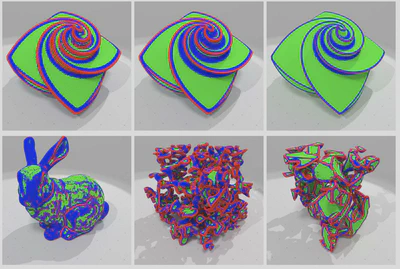Scale-space Feature Extraction on Digital Surfaces
Abstract
A classical problem in many computer graphics applications consists in extracting significant zones or points on an object surface, like loci of tangent discontinuity (edges), maxima or minima of curvatures, inflection points, etc. These places have specific local geometrical properties and often called generically features. An important problem is related to the scale, or range of scales, for which a feature is relevant. We propose a new robust method to detect features on digital data (surface of objects in Z3), which exploits asymptotic properties of recent digital curvature estimators. In [1, 2], authors have proposed curvature estimators (mean, principal and Gaussian) on 2D and 3D digitized shapes and have demonstrated their multigrid convergence (for C3-smooth surfaces). Since such approaches integrate local information within a ball around points of interest, the radius is a crucial parameter. In this article, we consider the radius as a scale-space parameter. By analyzing the behavior of such curvature estimators as the ball radius tends to zero, we propose a tool to efficiently characterize and extract several relevant features (edges, smooth and flat parts) on digital surfaces.

@article{levallois15feature,
author = {Levallois, Jérémy and Coeurjolly, David and Lachaud, Jacques-Olivier},
doi = {10.1016/j.cag.2015.05.023},
hal_id = {hal-01149102},
journal = {Computers and Graphics, SMI 2015 Proceedings},
keywords = {multigrid convergence ; curvature estimation ;
integral invariants ; feature extraction ;
scale-space ; digital geometry},
month = {October},
number = {C},
pages = { 177--189 },
pdf = {https://hal.archives-ouvertes.fr/hal-01149102/file/main.pdf},
publisher = {Elsevier},
title = {Scale-space Feature Extraction on Digital Surfaces},
url = {https://hal.archives-ouvertes.fr/hal-01149102},
volume = {51},
year = {2015}
}